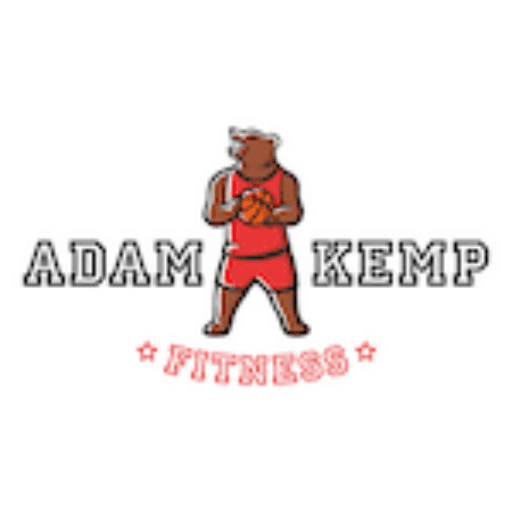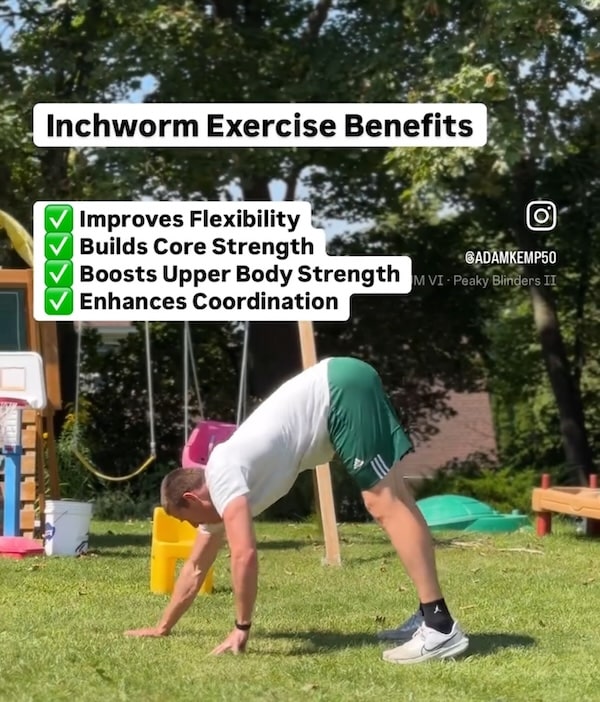Inchworm Exercise Benefits: Is the Inchworm a Good Exercise?
The inchworm exercise is a dynamic, full-body movement that is particularly effective as a warm-up for strength workouts or team sports.
Research indicates that dynamic warm-ups like the inchworm can significantly enhance athletic performance by improving flexibility, increasing core temperature, and activating key muscle groups.
This exercise is ideal for preparing the body for more intense physical activity, whether in the gym or on the field. Additionally, it’s a fun and engaging exercise for kids, helping them develop coordination and strength while keeping them active and entertained.
As a professional basketball player, I’ve used the inchworm exercise with my teams at all levels, from high school athletes to professional players.
It’s an excellent way to get your core and shoulders ready for training or games, and it serves as a solid exercise for building shoulder and core strength on its own.
Plus, it provides a great stretch for the hips and hamstrings, making it a staple in my warm-up routines!
What is the Inchworm Exercise?
The inchworm exercise is a dynamic movement that combines flexibility, strength, and stability in one fluid motion.
Named after the way an inchworm moves, this exercise involves bending forward to touch the ground, walking your hands out into a plank position, and then walking your feet forward to meet your hands.
It engages multiple muscle groups, including the core, shoulders, hamstrings, and calves, making it an effective full-body exercise.
The inchworm is often used as a warm-up to prepare the body for more intense physical activity, but it can also be incorporated into workouts to build strength and improve flexibility.
How to Do the Inchworm Exercise
Mastering the inchworm exercise requires proper technique to maximize its benefits and avoid unnecessary strain.
This movement is simple yet highly effective, making it accessible for beginners while still challenging enough for advanced athletes.
By performing each step with control, you can enhance flexibility, build core and shoulder strength, and improve overall movement efficiency.
Follow the step-by-step guide below to ensure you’re executing the inchworm correctly and reaping its full benefits.
- Start Position: Stand tall with your feet hip-width apart. Engage your core, and keep your arms by your sides.
- Reach Down: Bend at the hips and slowly lower your hands to the floor in front of you. Keep your legs as straight as possible, but allow a slight bend in the knees if necessary to reach the ground.
- Walk Out: Once your hands are on the floor, begin to “walk” them forward, moving out into a plank position. Keep your core tight and your body in a straight line from head to heels.
- Hold Plank: Briefly hold the plank position for a second or two to engage your core and stabilize your shoulders.
- Walk Back: Reverse the movement by walking your hands back towards your feet, keeping your legs as straight as possible.
- Stand Up: Once your hands are near your feet, lift your torso back to the starting position, and repeat the process.
Inchworm Exercise Benefits
The inchworm exercise is a highly effective movement that enhances neuromuscular coordination, dynamic flexibility, and functional strength.
It serves as both a warm-up and a full-body conditioning exercise, activating key muscle groups while improving mobility and stability.
The controlled, sequential nature of the movement engages multiple physiological systems, making it a versatile addition to any training routine.
Develops Dynamic Flexibility & Mobility
The inchworm actively stretches and mobilizes the hamstrings, gastrocnemius (calves), hip flexors, and shoulders, promoting increased range of motion.
Unlike static stretching, the inchworm maintains continuous movement, which facilitates synovial fluid circulation within the joints, reducing stiffness and preparing the body for more dynamic activities.
Improves Core Stabilization & Trunk Control
During the plank phase, the rectus abdominis, transverse abdominis, and obliques must contract isometrically to stabilize the torso.
This activation helps improve lumbo-pelvic control, reducing excessive spinal extension or flexion and mitigating the risk of lower back strain during movement.
Strengthens the Shoulder Girdle & Scapular Stabilizers
Walking the hands forward into a plank engages the serratus anterior, trapezius, and rhomboids, key muscles responsible for shoulder stability and proper scapular mechanics.
This controlled weight-bearing movement reinforces scapulothoracic stability, which is essential for overhead movements, pressing exercises, and overall upper body resilience.
Engages Lower Limb Muscles for Eccentric Strength
The eccentric (lengthening) contraction of the hamstrings and gastrocnemius when reaching forward develops flexibility while also improving muscle control under tension.
This type of eccentric loading is particularly beneficial for preventing hamstring strains, reducing chronic hamstring tightness, and improving sprint mechanics.
Promotes Proprioception & Neuromuscular Coordination
The inchworm integrates full-body movement patterns, requiring coordinated activation of multiple muscle groups.
This enhances proprioception—the body’s ability to sense joint position and movement—by engaging cutaneous receptors, muscle spindles, and Golgi tendon organs in the hands, feet, and core.
Elevates Heart Rate & Prepares the Cardiovascular System
As a rhythmic, multi-joint movement, the inchworm stimulates the sympathetic nervous system, leading to increased heart rate, oxygen uptake, and blood flow to working muscles.
This makes it an ideal preparatory exercise before high-intensity activities such as sprinting, weightlifting, or sports-specific drills.
By incorporating the inchworm into your routine, you can enhance movement efficiency, improve muscular activation patterns, and develop functional strength in a way that directly translates to athletic performance and daily activities.
Inchworm Exercise Muscles Worked
The inchworm is a compound movement that activates multiple muscle groups across the body, improving strength, mobility, and neuromuscular coordination.
By engaging both upper and lower body muscles in a controlled, dynamic sequence, this exercise enhances movement efficiency and muscular endurance.
Core Muscles: Stability & Trunk Control
- Rectus abdominis, transverse abdominis, obliques, and erector spinae
- These muscles contract isometrically during the plank phase to stabilize the spine and prevent excessive lumbar extension or rotation.
- The deep core engagement supports lumbo-pelvic control, essential for maintaining balance and reducing the risk of lower back strain.
Upper Body: Shoulder & Arm Strength
- Deltoids, trapezius, serratus anterior, triceps, and pectoralis major
- Walking the hands forward into a plank activates the shoulders and scapular stabilizers, improving shoulder endurance and resilience.
- The triceps and chest muscles are engaged during the forward walk and plank hold, contributing to pressing strength and upper-body endurance.
Lower Body: Flexibility & Posterior Chain Activation
- Hamstrings, gastrocnemius (calves), gluteus maximus, and hip flexors
- The hamstrings and calves are eccentrically lengthened when reaching for the ground, improving flexibility and mobility.
- The glutes and hip flexors activate as you transition from the plank back to a standing position, supporting hip extension and functional movement patterns.
By integrating the inchworm into your training routine, you can develop full-body strength, dynamic flexibility, and core stability, all of which contribute to improved athletic performance and injury prevention.
Safety Tips
To maximize the benefits of the inchworm exercise and prevent injury, consider the following safety tips:
- Maintain Proper Form: Keep your core engaged and your body in a straight line during the plank to avoid sagging or arching your lower back. Proper form is essential to prevent lower back strain and ensure that the targeted muscles are effectively engaged.
- Control the Movement: Perform the exercise slowly and with control to maximize muscle engagement and minimize strain on your joints. Rushing through the movement can reduce its effectiveness and increase the risk of injury.
- Modify If Needed: If you have limited hamstring flexibility, slightly bend your knees when reaching for the floor. You can also reduce the range of motion by not walking out as far. These modifications ensure that the exercise remains accessible while still providing a good workout.
- Warm-Up Properly: As with any exercise, ensure you’re adequately warmed up to avoid muscle strains, especially in the hamstrings and lower back. Consider adding some basic dynamic stretches or light cardio before performing the inchworm to prepare your muscles.
Read Next: How to Warm-Up for Sprinting



